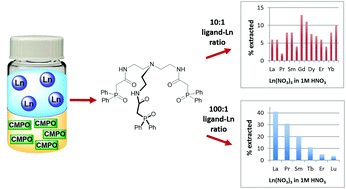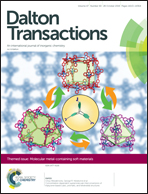Lanthanide extraction selectivity of a tripodal carbamoylmethylphosphine oxide ligand system†
Abstract
Four tripodal carbamoylmethylphosphine oxide (CMPO)-based ligands are reported here and assessed with regard to lanthanide (Ln) coordination chemistry and selective extraction of lanthanide ions from aqueous solution. Inspired by previous liquid–liquid extraction studies that suggested a preference for terbium(III), the current work further probes the extraction behavior of a tris-(2-aminoethyl)amine (TREN) capped, ethoxy substituted CMPO ligand with respect to the entire series of lanthanides. Upon confirmation of Tb3+ extraction selectivity versus the whole series, experiments were conducted to assess the effect of increasing the alkyl chain length within the ligand TREN cap, as well as changing the CMPO substituents by replacing the ethoxy groups with more hydrophobic phenyl groups to promote solubility in the organic extraction solvent. Extraction efficiencies remained low for most lanthanides upon increasing the cap size, with %E values consistently around 5%, and a complete loss of Tb3+ preference was noted with a decrease in %E from 18% to 3.5%. For the agent employing the original, smaller TREN cap but with phenyl substituents on the CMPO units, an increase in extraction toward the middle of the row was again observed, albeit modest, with relatively high %E values for both Gd3+ and Tb3+versus the other lanthanides (13 and 11%, respectively). A more dramatic extraction selectivity for the phenyl substituted ligand was achieved upon modification of the ligand to metal ratio, with a 100 : 1 ratio resulting in a near linear decrease in %E from 41% for La3+ to 3.7% for Lu3+. Finally, modification of the TREN capping scaffold by adding an oxygen atom to the central nitrogen led to consistently low %E values, revealing the effect of TREN cap oxidation on Ln extraction for this tripodal CMPO ligand system.

- This article is part of the themed collections: Inorganic chemistry approaches to saving critical elements: Recovery, Reuse and Recycling and Molecular metal-containing soft materials


 Please wait while we load your content...
Please wait while we load your content...